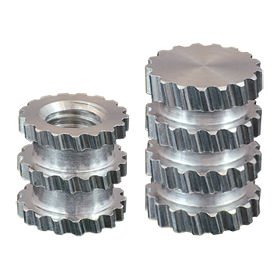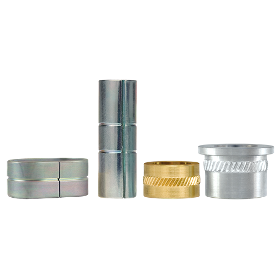- europages
- >
- COMPANIES - SUPPLIERS - SERVICE PROVIDERS
- >
- moulds and cavities
Results for
Moulds and cavities - Import export

SPIROL
Germany
Moulded-In Inserts are placed over core pins by an operator or a pick-and-place robot prior to the closure of the mould cavity during the plastic injection process. Moulded-In Inserts offer exceptional torque and pull-out resistance due to unrestricted plastic flow around the Insert body, and are often the Insert of choice for thermosets and engineered plastics with a high percentage of filler. The minor thread diameter tolerance is controlled to ensure positive positioning and perpendicularity of the Insert on the core pin during the moulding process. Series 63 is symmetrical eliminating orientation and Series 65 is the same body style in a blind ended version. SPIROL's Moulded-In Inserts are made from 2024 aluminium, a light-weight, lead-free grade. SPIROL’s Series 63 and Series 65 Moulded-In Aluminium Inserts are available in thread sizes ranging from M4 (8-32) up to M8 (5/16-18).
Request for a quote
SPIROL
Germany
SPIROL manufactures several different types of Moulded-In Compression Limiters that are designed to be installed into the plastic assembly during the moulding process. When moulding Compression Limiters into the plastic assembly, the moulding time is increased as the operator or a pick-and-place robot must load each Compression Limiter over the core pin(s) prior to closing the mould cavity. Precise placement of the Moulded-In Compression Limiter over the core pin is required; otherwise mould damage can occur. SPIROL Standard Moulded-In Compression Limiters include: The Series CL500 Moulded-In, Series CL460 Moulded-In - Oval, Series CL600 & CL601 Aluminum and Series CL800 & CL801 Brass.
Request for a quote
HEXPOL TPE GMBH
Germany
Introduction Mediprene BM is a range of thermoplastic elastomers (TPE) optimised for medical blow moulding applications. What is blow moulding? Blow moulding is a manufacturing process that is used to produce hollow parts such as bottles, balloons and bags. The process begins with melting the TPE and forming it into a tube, called a parison. The parison is clamped into a divided mould, the tube is pinched at one end, welding it together and then air is blown into it. The air pressure inflates the TPE out to match the mould cavity. Once the TPE has cooled and hardened the mould opens and the part is ejected. Mediprene BM TPE We have designed the Mediprene BM TPE compounds to have high melt strength, giving time to close the mould around the extruded parison while allowing sufficient stretchability during inflation. They also offer good welding in the pinchoff area of the blow mould. They can easily be coloured and give a smooth surface to the finished part. Applications The TPE can
Request for a quoteDo you sell or make similar products?
Sign up to europages and have your products listed
Results for
Moulds and cavities - Import exportNumber of results
3 ProductsCountries
Company type